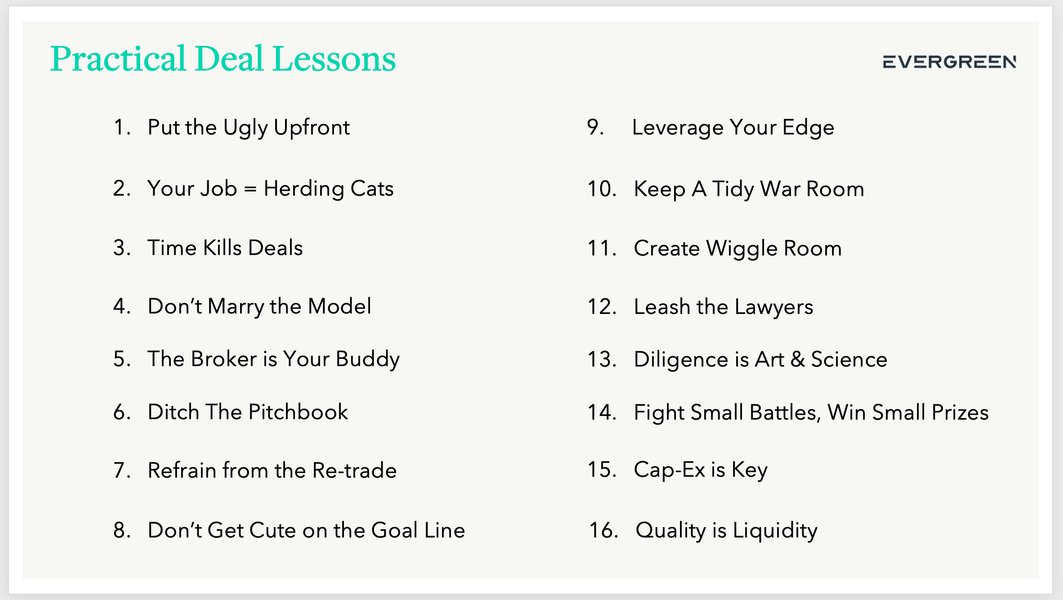Investing

It’s hard to get really depressed until your dreams come true. Once your dreams come true and you realize you feel the same way you did before then you get a feeling of hopelessness.
Matt Perelman & Alex Sloane - The Art of Franchise Investing
podcasts.apple.comIncredible interview with two founders in the thick of building their business.

1. Put the Ugly up front.
Sellers often hide things. Perhaps not always with malice, but its hard to see “the dog” in your deal. That’s the "‘endowment effect’ in action, we all have a hard time viewing the things we own with objectivity.
But the market is brutal: it will tell you your baby is ugly with a straight face.
The problem with sugar-coating the deal is the skeletons almost always surface in due diligence. These cause fights, delays, occasional lawsuits and plenty of cancelled deals.
If that info was presented up-front the buyer might have been fine with it. Or perhaps their price would have been lower but acceptable.
Because in a competitive process, the market can “price” the impact of that skeleton and the animal spirits of an auction might have caused buyers to overlook it.
But say you’re in day 60 of a deal when a problem surfaces. The buyer tends to have a bit more leverage (you want to sell and would rather not start over). The problem is you now have no idea how the market would discount (price) your skeleton.
You’ll only know how your buyer feels about it - NOT GREAT - when they come back with a huge and perhaps vindictive price cut.
You’ll blame them for “re-trading” but it was probably your fault for not putting the ugly up front.
2. Your Job = Herding Cats
This applies to the point person on both the buyer and seller side. There are a million tiny things that need to get a deal across the finish line. You don’t control a lot of them.
Getting vendors, lawyers, lenders, title agents, 3rd party consultants, etc. etc. all lined up and in the right sequence to close is a minor miracle. Every single time.
I just tried to avoid being the bottleneck on anything. Fire back quick responses and clear timeline communication to everyone early and often. Check in frequently so they don’t forget your deal. Don’t assume they care or are diligently working away on your precious deal.
People get busy. You’re not their only deal. Gentle check-ins and getting to know them personally (when you don’t need something from them) go a long way here.
3. Time Kills Deals
The longer things drag on, the more shit (sorry) can go sideways.
Interest rates move
Better deals surface and distract buyers
Life gets in the way - sometimes people get really sick, divorces happen
All sorts of things pop up with time. Deals have a momentum to them, keep pushing.
4. Don’t Marry the Model
This is probably good relationship advice too.
Some buyers (including me when I started) over index on the financial model instead of getting out in the real world to diligence the deal, meet with vendors, sellers, lenders, etc.
The answer is almost certainly not in an Excel spreadsheet.
5. The Broker is Your Buddy
I don’t care what side you’re on, the broker works for the deal. This is a good thing as that’s kind of the whole point. You need to treat these people well. They are absolutely essential to your success.
The pros and those with long-term mindsets have internalized this. If you want to do a lot of deals realize this is a multi-player, multi-level game. Those that treat the deal as a life or death, one-time game probably aren’t thinking clearly.
6. Ditch the Pitch-book
The offering memo with the pretty pictures and fluff about the local economy and burgeoning craft brewery scene are nice. However, you’ll be far better off taking the broker out for one of those beers than pouring over every page of the marketing materials.
7. Refrain from the Re-Trade
Sometimes it’s unavoidable (especially if the seller hides things or giant material capital items surfaces). But I think it’s best to go in with this thought as a default and only ask for credits on major surprises that kill the numbers.
8. Don’t Get Cute on the Goal Line
Please don’t throw it on “the one”.
Give the ball to Beast Mode and PUNCH THAT THING THROUGH. Sorry, this will be the only sports metaphor.
The deal only counts when the wires hit.
Somebody flags a ticky-tack issue that might delay closing a day??
“No. Who cares. Pound sand, we’re closing.”
Fire off those wires, bombs away!
Tiny things can be cleaned up post closing.
I know this sounds like the rantings of an investment guy. But I’m biased as I cut my teeth on acquisitions not asset management. And I’ve seen two lenders back out of deals the last second due to random macro issues.
So don’t take lightly to someone with zero skin in the game saying, “Ummm, we’re getting pretty tight on timing, let’s just push closing two weeks”.
Push everyone to the agreed upon closing date for as long as you can. The second you say, “okay that sounds fine, I guess” is the second everyone take their foot off the gas and procrastinates until that next deadline.
Close that puppy.
9. Leverage Your Edge
This is timely. Deals are hard to do right now.
I think they’re easier if you have some sort of secret sauce. The holy grail of acquisitions is when edge lets you buy market rate deals (or even those with a slight premium).
Having a unique advantage (whether it’s operating skill or a lower cost of capital) that helps you hit your numbers easier than everyone else is a super power that greases the wheels during deals.
If you have zero operational alpha, due diligence becomes life and death when the market is tight. If you’re a Beta Buyer praying for rent growth or cap rate compression to hit your hurdles, you have very little margin for error. That ends up killing a lot of deals.
Look at the best software roll-up firms for inspiration here (ex: Constellation Software). They are acquisition machines in large part because they can hit just about every “bid” knowing what their operations team is capable of post-closing.
If you have no discernible edge, patience and downturns are your friends.
10. Keep a Tidy War Room
A small point, but file hygiene in the due diligence portal matters. You don’t want people relying on 10,000 emails flying around for the correct documents.
This cuts back on the “Can you send me….” requests.
You also don’t want to be searching for random things constantly. Get clear lists over to the buyer or seller at the start of diligence.
When in doubt, default to DropBox.
11. Leash the Lawyers
I loved our lawyers. If you’re a lawyer, I’m sure you’re excellent. Please don’t sue me.
But maybe don’t let the lawyers run the deal until you’ve worked with them a long time.
Their incentives are drastically different than yours and they have a tendency to fight the wrong fights (if they don’t know you and what you care about well).
12. Diligence is Art & Science
The key to diligence is being detailed enough to catch everything, but then knowing what to ignore.
Diligence is about risk assessment.
You can’t get rid of all risk so decide what you can live with, then ask am I being compensated for that risk?
14. Fight Small Battles, Win Small Prizes
Pretty self explanatory, pretty hard to remember.
15. Cap-Ex is King
If you’ve gotten this far, you probably know I’m a bit obsessed about cap-ex when it comes to investing.
16. Quality = Liquidity
The easiest deals to buy and sell are the highest quality assets. It’s the ones that are a bit shoddy that are a hassle and take a few attempts to sell. Anyone whose ever had a lender property tour go south knows what I’m taking about.
Life’s too short. Go for great.
Conclusion
If I had to pick a short-cut common thread to success here, I’d say:
Figure out what’s critical to move the deal forward and do it with urgency while ignoring the noise.
And the next time you’re in the throes of a deal that’s falling apart, I hope you keep your sanity and that something above is useful.

Like travelers on the moving walkway, it was easy for businesspeople and investors to think they were doing a great job all on their own. In particular, market participants got a lot of help in this period as they rode the 10-year-plus bull market, the longest in U.S. history. Many disregarded the benefits that ensued from low interest rates. But as one of the oldest investment adages says, we should never confuse brains with a bull market.
I love Hayek’s word “malinvestment,” because of the validity of the idea behind it: in low-return times, investments are made that shouldn’t be made; buildings are built that shouldn’t be built; and risks are borne that shouldn’t be borne. People with money feel they must put it to work, since cash yields little or nothing. They drop their risk aversion and, as discussed below, compete spiritedly for lending or investing opportunities with higher potential returns. The investment process becomes all about flexibility and aggressiveness, rather than thorough diligence, high standards, and appropriate risk aversion.
Providers of capital vie to be the one who gets the deal. To compete for deals, the “winner” must be willing to accept low returns from possibly questionable projects and reduced safety, including weaker documentation. For this reason, it’s often said that “the worst of loans are made at the best of times.”
The availability of capital fluctuates radically. Whereas in times of stringency, capital may not be available even to quality borrowers for valid purposes, in periods of easy money, capital typically becomes available to weaker borrowers, in large amounts, for almost any purpose. Things that couldn’t be financed in tighter times are deemed acceptable.
But it must be noted that cheap leverage doesn’t make investments better; it merely amplifies the results.
This is one of the foremost reasons for the adage “never forget the six-foot-tall man who drowned crossing the stream that was five feet deep on average.” Heavy leverage can render companies fragile and make it hard for them to get through the proverbial low spots in the stream.
It’s common for people to conclude that the environment they’ve lived through for a while is “normal,” and that the future will entail more of the same. For this reason, people who have gotten used to low interest rates may think rates will always be low and make decisions based on that assumption. As a result, investor due diligence or corporate planning may assume that the cost of capital will remain low. This can become a source of trouble if rates are higher when financing is actually sought.
However, investors learned a lesson that has been repeated throughout financial history: catalysts for interest rate increases inevitably pop up, and thus perpetual prosperity and “the end of cycles” turn out to be nothing but wishful thinking.
Elevated risk taking, underestimating future financing costs, and increased use of leverage often lie behind investments that fail when tested in subsequent periods of stringency, bringing on the next crisis and perhaps the need for the next rescue.
Cycles don’t have an obvious beginning and end. The only requirement for something to correctly be considered a full cycle is that it must include four components: (1) a movement from a norm to a high, (2) a move away from that high back toward the norm, (3) a move from the norm to a corresponding low, and (4) a movement from that low back toward the norm. Any of these can be labeled the start of a cycle, providing it goes on to include all four.
When money is easy, few people opt to sit out the dance, even though the adverse results described above can reasonably be anticipated. When faced with the choice between (a) maintaining high standards and missing deals and (b) making risky investments, most people will choose the latter. Professional investment managers especially may fear the consequences of idiosyncratic behavior that’s bound to look wrong for a while. Abstaining demands uncommon strength when doing so means departing from herd behavior.
Finally, what will we see moving forward? It now appears that sometime in 2024, the Fed will declare victory against inflation and begin to reduce the fed funds rate from today’s somewhat restrictive 5.25-5.50%. The current “dot plot,” which summarizes the views of Fed officials, shows three 25-bps rate cuts in 2024, bringing the rate to 4.60%, and then more cuts in 2025, taking it to the mid-3s. However, today’s consensus thinking among investors seems to be considerably more optimistic than that, anticipating more/earlier/bigger rate cuts.
At present, I believe the consensus is as follows:
Inflation is moving in the right direction and will soon reach the Fed’s target of roughly 2%.
As a consequence, additional rate increases won’t be necessary.
As a further consequence, we’ll have a soft landing marked by a minor recession or none at all.
Thus, the Fed will be able to take rates back down.
This will be good for the economy and the stock market.
Before going further, I want to note that, to me, these five bullet points smack of “Goldilocks thinking”: the economy won’t be hot enough to raise inflation or cold enough to bring on an economic slowdown. I’ve seen Goldilocks thinking in play a few times over the course of my career, and it rarely holds for long. Something usually fails to operate as hoped, and the economy moves away from perfection. One important effect of Goldilocks thinking is that it creates high expectations among investors and thus room for potential disappointment (and losses).
I don’t have an opinion as to whether the consensus described above is correct. However, even granting that it is, I’ll still stick with my guess that rates will be around 2-4%, not 0-2%, over the next few years. Do you want more specificity? My guess – and that’s all it is – is that the fed funds rate will average between 3.0% and 3.5% over the next 5-10 years. If you think I’m wrong, ask yourself whether you’d put your money on a different half-point range. (Before readers protest my uncharacteristic descent into forecasting, I’ll point out that, at Oaktree, we say it’s okay to have opinions on the macro; it’s just not okay to bet clients’ money on them. We invest with an awareness of current macro conditions, but our investment decisions are always based on bottom-up analysis of companies and securities, not macro forecasts.)
PTM’s investment thesis is identifying neighborhoods where the population is growing and housing is in short supply. We then strive to build accessible rental housing that is attainable for at least 65 percent of the population living within a 1-mile radius. This is a strategy that transcends OZs and makes investing in the current economic landscap
... See moreMeyer: PTM takes a top-down and bottom-up approach to identifying potential OZs for development in Florida. We are bullish on the long-term prospects for the state of Florida due to its strong economic potential, rapid population growth and job opportunities.
When determining which areas of Florida to develop in, we look at the job and population growth projections of specific counties and neighborhoods. From there, we use a data-driven approach to narrow our search down to specific communities and streets overlaid with the Opportunity Zone map to see a path of growth in that specific neighborhood. The locations of our current projects in Downtown Miami, Sarasota and St. Petersburg are emblematic of our selection criteria.
“For a long time, I looked for consensus. I think consensus is really the enemy of scale, and so I used to say, “Whenever we’re making an important decision, there should be winners in the room and losers. We shouldn’t find that negotiated settlement that everyone is happy with. Somebody should be unhappy, three or four people should walk out unhap
... See moreIdeas related to this collection